Disclosure: Meeple Mountain received a free copy of this product in exchange for an honest, unbiased review. This review is not intended to be an endorsement.
In The Spill, you’re tasked with managing an oil spill and saving the affected wildlife. By working together as a team, you’ll try to keep the ever-flowing oil from overspilling into other areas and contaminating the local sea creatures and birds.
Unlike most cooperative games with negative events on each turn, the constant oil spill here comes in the form of six-sided dice that are dropped in an oil rig/dice tower in the middle of the board.
Let’s get the game set up so you can see what I mean.

Setup
Unfold the game board and set it in the middle of the table. Then take the six long, narrow pieces of laminated cardboard and assemble them to create an outer-edged square with a cross in the center. Align this up with the four corner sections drawn onto the board. This allows for each of the four inner squares to correspond with the four ocean quadrants of the board.
Next, build the oil rig. The round molded plastic with the top that slopes off in four directions is the bottom. Insert the pegs in the slots and add the two dice tower funnels, turning it into an oil rig/dice tower. Then set the base into the center cross in the middle of the board, using the slits in the base to align the oil rig/dice tower.
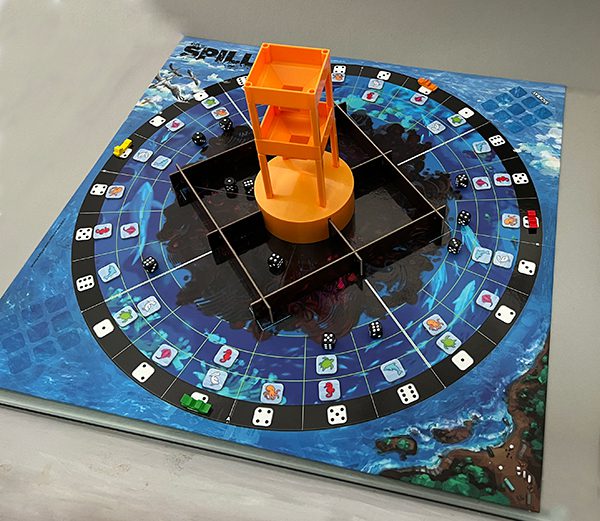
In each sector, there are animals pre-printed on the board. Take the animal tokens and place one on each corresponding section of the board, Clean side face up. (More on this later.)
Place the situation board to the side with the black oil drop token to the far left of the Spill Out tracker at the top, on the difficulty setting of your choice. Then set the wooden orange cubes in their places across the top of the Removed Oil chart and down the left edge of the Rescued Marine Life table.
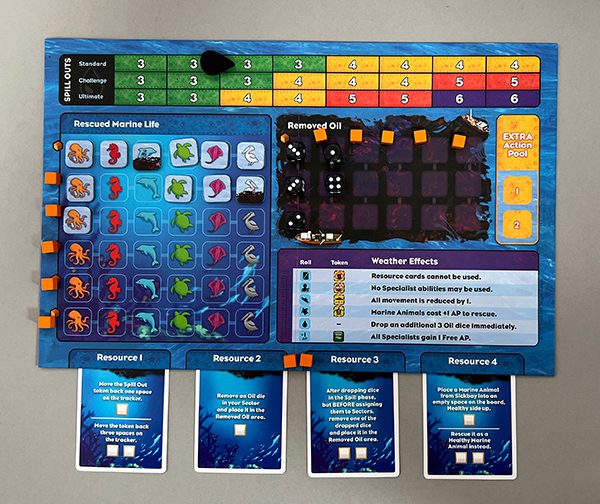
Review the Win Condition cards. Each card has a dot in the upper left corner to indicate its difficulty, with one dot being Easy and three dots being Hard. Choose one for your game and set the others aside.
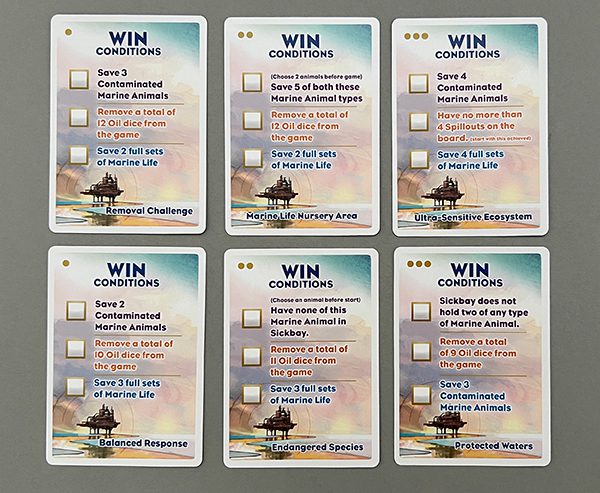
Take the Resource cards and select four to start the game with, setting them face-up at the bottom of the Situation Board. These bonus actions can be used throughout the game, provided you have acquired enough orange cubes to trigger them.
Each game will require four Specialists, one per quadrant of the board. (In games of fewer than four players, decisions about the extra Specialists’ actions can be shared amongst the players.) Taking into consideration your chosen Winning Conditions, select your Specialists carefully. After selecting a Specialist, roll one of the six-sided oil dice to determine where your Specialist’s boat will start the game.

Finally, to simulate the start of the oil leak, take eight oil dice and drop them into the oil rig/dice tower. The dice will fall into several of the four quadrants. Place each die in the sector of that quadrant that matches the pips on the die.
And now you’re ready to play.
Win Some, Lose a Lot
Before diving into the gameplay, let’s cover the win/lose conditions.
Winning is determined by the Win Condition card you chose. Each time you meet one of these winning conditions, place a marker on that condition. (Frustratingly, there aren’t enough orange cubes included in the game for this, so you’ll need to figure out something on your own.)
You will not need to meet all the winning conditions on a single turn. After you meet the third winning condition and there are no losing conditions present on the board, you win.
There are three ways you can lose The Spill, each of which you’ll be fighting to prevent throughout much of the game. I’ll explain each of these in more detail below, but just know that you’ll lose the game if, at the end of a player’s turn, any of these are present on the board:
- If Sickbay has one of each the six types of animals
- If Sickbay has three of any single type of animal
- The board has six Spill Outs
Playing the Game
Start of Turn Bad: When Bad Stuff Happens
On a turn, players will start by referring to the Spill Out token on the Situation board to determine how many dice they’ll drop into the oil rig/dice tower. After they’ve spilled into the quadrants, place them in the appropriate sector as indicated by the pips on the die.
If there’s already a die in that quadrant, the oil spill spreads further into the sector. Place the new die in the next section further from the oil rig/dice tower. If there’s an animal in that part of the sector, turn it from its Clean side to the Contaminated side.
If there are already two oil dice in that section, place the new die in the third part of that sector and add a Spill Out token to the outer edge of the sector. And, if there’s already a Spill Out token in that sector, the overflow moves clockwise around the sector/quadrant.

For each Spill Out, move the Spill Out tracker to the right one space. Eventually, this will mean everyone is dropping more and more dice into the oil rig/dice tower at the start of each turn.
Taking Actions
Each turn, you’ll have 4 action points (AP) to use. You can:
- Move one or two sectors for 1 AP
- Move one oil die from a sector back into the bag for 1 AP
- Remove an oil die from the game and place it on the Situation board for 3 AP
- Rescue a healthy animal for 1 AP
- Rescue a Contaminated animal for 2 AP
If you want to take a fifth or sixth action on a turn, you can. However, for each extra action, you’ll take an oil die from the bag and add it to the Situation board. The next player must then add these dice to their dice spilled into the oil rig/dice tower on their turn.
As with a lot of this type of cooperative games, during your first few turns things will feel manageable. You’ll move around, rescue a few animals, and push a few oil dice back into the bag. Maybe you’ll even spend 3 of your 4 action points to remove an oil die from the game.
Then, somewhere around the fifth or sixth turn, you’ll realize you’re getting close to several Spill Outs on the board. Or maybe you’ve already had one in a sector you couldn’t get to in time because you were too busy rescuing animals.
That’s because in The Spill, the game quickly goes from bad to worse. It’s difficult to balance fulfilling those winning conditions with keeping the losing conditions at bay.
End of Turn
Just before the next player takes their turn, you’ll all need to check each sector for Contaminated animals. Any that are still left on the board at the end of a turn are moved into Sickbay. Given that any Contaminated animals are moved to Sickbay at the end of the turn in which they become contaminated, there will be plenty of circumstances when you simply cannot rescue them.
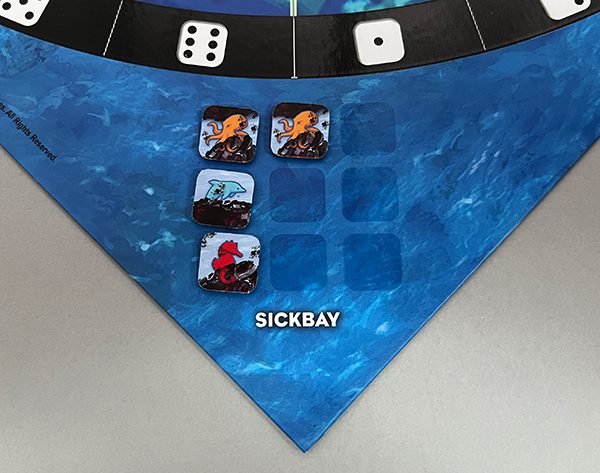
And remember, three of any kind of animal in Sickbay or one of each of the six animals in Sickbay at the end of a turn and you all lose the game.
Thoughts
I’m not sure what it says about The Spill, but I’ve only won the game when I’ve played solo. The games with my weekly gaming group have been lost due to each of the three losing conditions. Some of that is likely because in my solo games I’ve been quick to use 3 action points to eliminate oil dice from the game early on before having to manage too many disasters.
With the requirement of always playing with four specialists, there are no special rules for solo play. This means the game is equally challenging regardless of the player count.
The Spill gets a lot of things right. Choosing your own winning conditions gives players some choice over how the game will be played and provides a lot of replayability.
Thematically, the use of the black dice to represent oil was spot on. Having the oil rig be a dice tower to generate the oil spill at the start of each turn was an inspired choice. It just makes sense on the board—and it looks good, too.
That being said, there are some serious misses for me with the game.
Pre-printing the marine life onto the board, which means every game will feature the same animals in the same location in every game, felt a bit static to me. In a game where the winning conditions are left up to the players, it wouldn’t have been that difficult to create six different starting animal conditions which could be left up to the players to choose or a simple roll of one of the oil dice.
As I’ve said, that oil rig/dice tower is both thematic and looks great on the board. Unfortunately, for each player, it also completely blocks the opposite side of the board. When people on all three other sides of the board are pointing to that quadrant across from you and discussing the animals, the SpillOuts, or how you’re about to lose the game because of conditions there, you can’t see a thing. That gets frustrating very quickly.
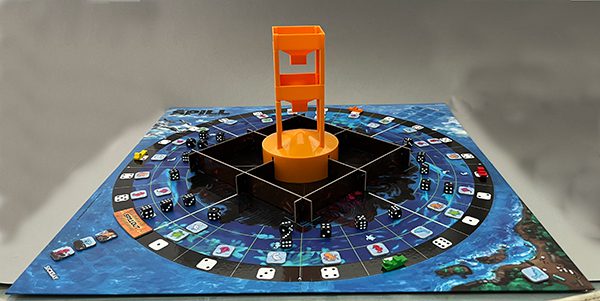
The box comes with a plastic insert for the components, but the storage makes little sense to me. I really don’t want to have to rebuild the oil rig/dice tower every time I play, but there’s no way to store it without taking it apart. The two compartments that hold the troughs of the dice funnels don’t match, so I’m not even sure I’m storing them properly. Since the publisher spent the money on a nice insert to hold the materials, this shouldn’t have been a big deal. (I cannot be the only one who looked at this insert and wondered how they were expecting all the game’s components to fit inside.)
Earlier, I mentioned that I’ve only won the game when playing solo. This is, in part, because The Spill is a difficult game to win. It’s not Ghost Stories difficult (I’ve given up on that game because I cannot understand how anyone can win it), but it’s on the scale. Many win conditions include rescuing a number of Contaminated animals, something that is very difficult to achieve. They must be Contaminated on your turn, within one or two sectors of where your boat is, and you must spend 1 action point to remove the oil die before spending 2 action points to rescue the animal.
This is where The Spill’s use of six-sided dice frustrates me. I just do not like that great of a luck factor in a game like this.
My lasting thoughts on The Spill have to do with another game, the granddaddy of cooperative save-the-population games, Pandemic.
Despite the oil rig/dice tower mechanic and the choose-your-own winning conditions, every time I’ve played The Spill, it’s felt like just a clever reskin of Pandemic: Instead of new cities being infected, we have dice dropping randomly into one of the four quadrants of the board; instead of Outbreaks we have Overspills; instead of finding cures, we’re saving animals; instead of selecting Specialists with their unique powers we’re selecting… oh, wait. Nevermind.
And that’s my lasting issue with The Spill. For as much as my weekly gaming group likes it (and they do), I’m decidedly meh about playing yet another game that feels like it tried to take Pandemic’s DNA and make something new, but without quite doing so.
However, if you or your gaming group like chucking dice and cooperative games, you should check out The Spill. You’ll certainly drop a lot of dice (frequently more than you’d like) while you’re working together to save the animals.
As for my copy, I’m probably going to be leaving it with my weekly gaming group, where it will find a welcome home.


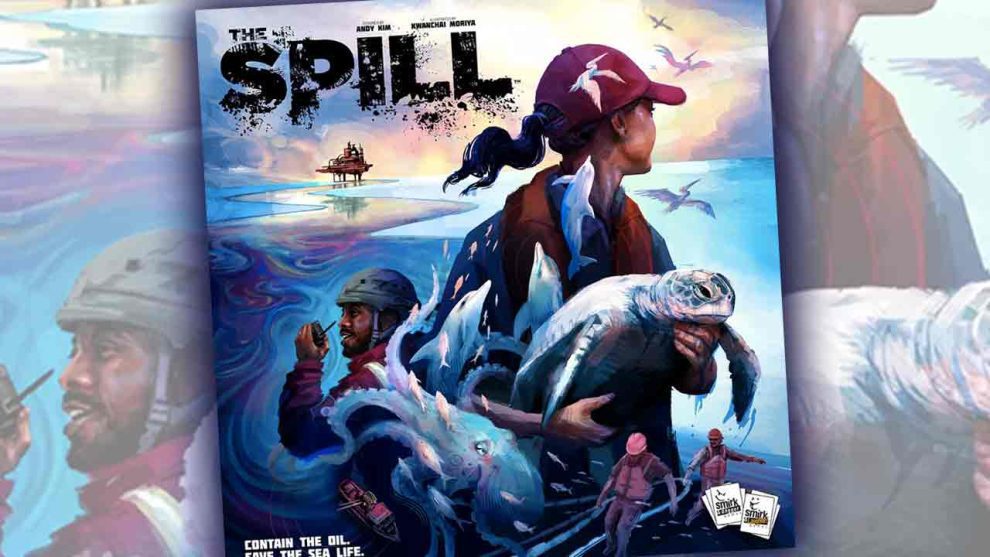








Add Comment